Basketball: Two plays to create mismatches
‘Toronto’
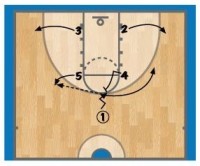 DIAGRAM 1: ‘Toronto’ (A). 1 dribbles into the set and receives a screen from 4. 5 pops out. 1 passes to 5. 1 moves to the opposite wing. 2 and 3 pop to the corners.
DIAGRAM 1: ‘Toronto’ (A). 1 dribbles into the set and receives a screen from 4. 5 pops out. 1 passes to 5. 1 moves to the opposite wing. 2 and 3 pop to the corners.
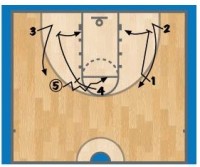 DIAGRAM 2: ‘Toronto’ (B). 4 sets a ball screen for 5. This sets a big-on-big screen outside the 3-point line, which places the defender at an even greater disadvantage.
DIAGRAM 2: ‘Toronto’ (B). 4 sets a ball screen for 5. This sets a big-on-big screen outside the 3-point line, which places the defender at an even greater disadvantage.
5 scrapes off the ball screen and drives toward the basket. 1 and 4 set downscreens for 2 and 3, which gives 5 two possible perimeter scoring threats available for passes, as well as occupying all four off-the-ball defenders, so that 5’s defender remains isolated in a much different defensive scenario that that defender usually is in.
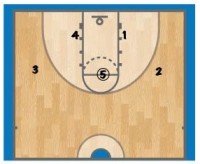 DIAGRAM 3: ‘Toronto’ (C). 5 may have the opportunity to drive all the way to the hoop or to kick the ball out to a true perimeter player for a shot. If not, the entry has placed all five offensive players in a balanced but modified 3-out and 2-in offense.
DIAGRAM 3: ‘Toronto’ (C). 5 may have the opportunity to drive all the way to the hoop or to kick the ball out to a true perimeter player for a shot. If not, the entry has placed all five offensive players in a balanced but modified 3-out and 2-in offense.
‘LA’
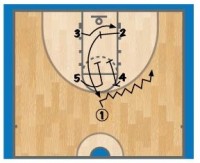 DIAGRAM 4: ‘LA’ (A). 1 dribble-scrapes off 4’s ball screen to the free-throw-line-extended area, which signals for 2 to cross screen for 3. 3 ends up on the ball-side block.
DIAGRAM 4: ‘LA’ (A). 1 dribble-scrapes off 4’s ball screen to the free-throw-line-extended area, which signals for 2 to cross screen for 3. 3 ends up on the ball-side block.
4 and 5 set a staggered screen for 2. 2 now comes free at the top of the key while also effectively eliminating any possible interior defensive support that 3’s defender needs to survive in an unfamiliar and potentially high-risk area — the low post.
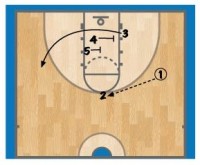 DIAGRAM 5: ‘LA’ (B). if 1 elects not to pass to 3 in the post, 1 reverses the ball to 2 at the top. 3 spins out of the initial ball-side block area and curls off a staggered “big on small” stagger screen set by 4 and 5.
DIAGRAM 5: ‘LA’ (B). if 1 elects not to pass to 3 in the post, 1 reverses the ball to 2 at the top. 3 spins out of the initial ball-side block area and curls off a staggered “big on small” stagger screen set by 4 and 5.
This places the two post players back inside and the three traditional perimeter players on the perimeter.












